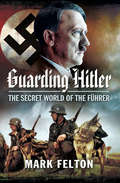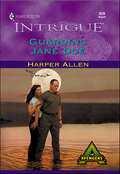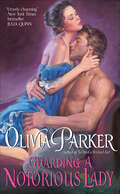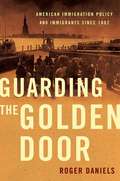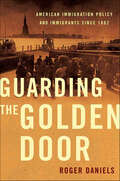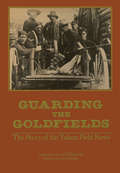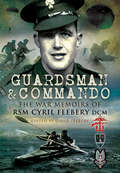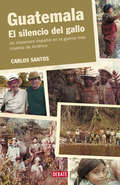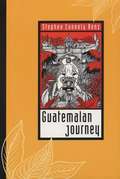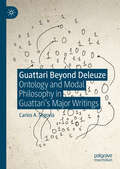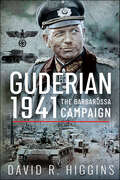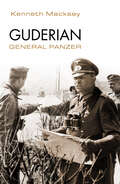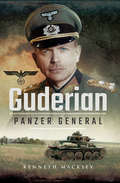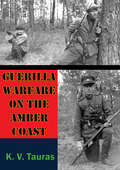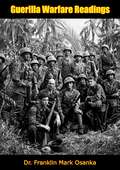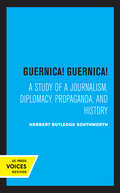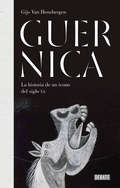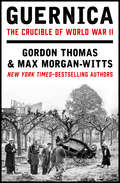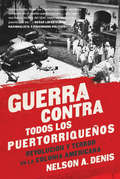- Table View
- List View
Guarding Hitler: The Secret World of the Führer
by Mark Felton&“A hive of interesting facts and almost unbelievable stories about Adolf Hitler . . . Well worth a look. Well worth a read.&” —War History Online Based on intelligence documents, personal testimonies, memoirs, and official histories, including material only declassified in 2010, Guarding Hitler provides the reader with a fascinating inside look at the secret world of Hitler&’s security and domestic arrangements. The book focuses in particular on both the official and private life of Hitler during the latter part of the war, at the Wolf&’s Lair at Rastenburg, and Hitler&’s private residence at Berchtesgaden, the Berghof. Guarding Hitler manages to offer fresh insights into the life and routine of the Führer, and most importantly, the often indiscreet opinions, observations, and activities of the &“little people&” who surrounded Hitler but whose stories have been overshadowed by the great affairs of state. It covers not only the plots against Hitler&’s life but the way security developed as a result. His use of &“doubles&” is examined as is security while traveling by land or air. As little has been written about the security and domestic life of Adolf Hitler, Guarding Hitler allows the reader to delve deeper into this previously overlooked aspect of the world&’s most infamous man. &“A fascinating view into the close world Hitler inhabited and which shaped his life and decisions.&” —Fire Reviews
Guarding Jane Doe (The Avengers)
by Harper AllenRENEGADE HEARTSIf he hadn't received a letter from a dead woman who'd once saved his life, Quinn McGuire wouldn't have agreed to help a frightened Jane Doe to honor his unpaid debt. As her twenty-four-hour protector, this burned-out soldier for hire would go to the wall to save "Jane" from a madman who claimed she'd committed a heinous crime. When their joint investigation uncovered her past, Quinn thought convincing Jane she was innocent of cold-blooded murder would be his greatest challenge-but he was wrong! Finding the courage to love Jane was...
Guarding a Notorious Lady
by Olivia ParkerA Regency battle of the sexes begins between the scandalously mischievous Lady Rosalind and her dashing secret guardian . . . A woman of pristine breeding, Lady Rosalind Devine is also an unrepentant meddler and snoop—which is why her brother refuses to leave her to her own devices while on his wedding trip. But Rosalind will not make things easy for any unseen, unwanted “nursemaid”—and vows to use her considerable wiles to expose her mystery guardian.Nicholas Kincaid, the Marquess of Winterbourne, agreed to secretly guard his friend’s spoiled, stubborn sister, though her infuriating penchant for mischief is causing him to question his decision. Though he’s bound by the rules of society—and friendship—Rosalind’s spirit and sensuality have sparked a fierce desire in Nicholas to play a very different role in her life, one that entails passion, ecstasy—and unavoidable scandal . . . Praise for the author“Utterly charming.” —Julia Quinn, New York Times–bestselling author of the Bridgerton novels“Sexy, funny . . . delightfully entertaining.” —Publishers Weekly
Guarding the Golden Door: American Immigration Policy and Immigrants since 1882
by Roger DanielsAs renowned historian Roger Daniels shows in this brilliant new work, America's inconsistent, often illogical, and always cumbersome immigration policy has profoundly affected our recent past. <P><P>The federal government's efforts to pick and choose among the multitude of immigrants seeking to enter the United States began with the Chinese Exclusion Act of 1882. Conceived in ignorance and falsely presented to the public, it had undreamt of consequences, and this pattern has been rarely deviated from since. <P><P>Immigration policy in Daniels' skilled hands shows Americans at their best and worst, from the nativist violence that forced Theodore Roosevelt's 1907 "gentlemen's agreement" with Japan to the generous refugee policies adopted after World War Two and throughout the Cold War. And in a conclusion drawn from today's headlines, Daniels makes clear how far ignorance, partisan politics, and unintended consequences have overtaken immigration policy during the current administration's War on Terror. <P><P>Irreverent, deeply informed, and authoritative, Guarding the Golden Door presents an unforgettable interpretation of modern American history.
Guarding the Golden Door: American Immigration Policy and Immigrants since 1882
by Roger Daniels“Immigration is now front-page news, and to grasp the background of current issues this is the book to read.” —David Reimers, author of Unwanted Strangers: American Identity and the Turn Against ImmigrationAs renowned historian Roger Daniels shows in this brilliant new work, America’s inconsistent, often illogical, and always cumbersome immigration policy has profoundly affected our recent past.The federal government’s efforts to pick and choose among the multitude of immigrants seeking to enter the United States began with the Chinese Exclusion Act of 1882. Conceived in ignorance and falsely presented to the public, it had undreamt of consequences, and this pattern has been rarely deviated from since.Immigration policy in Daniels’ skilled hands shows Americans at their best and worst, from the nativist violence that forced Theodore Roosevelt’s 1907 “gentlemen’s agreement” with Japan to the generous refugee policies adopted after World War Two and throughout the Cold War. And in a conclusion drawn from today’s headlines, Daniels makes clear how far ignorance, partisan politics, and unintended consequences have overtaken immigration policy.Irreverent, deeply informed, and authoritative, Guarding the Golden Door presents an unforgettable interpretation of modern American history.“Engaging and lively.” —Publishers Weekly“As Americans continue to debate immigration in a world divided by international terrorism, few books offer a fuller context for the key issues.” —Booklist“A powerful and provocative argument about why the United States has remained an immigrant country—and why it should stay one for its own benefit.” —Eric Rauchway, author of Murdering McKinley
Guarding the Goldfields: The Story of the Yukon Field Force
by Brereton GreenhousCanada’s gold rush of the late 1890s attracted dreamers and schemers from all over North America. Guarding the Goldfields is the story of the men sent to guard the Yukon and maintain order.
Guarding the Periphery: The Australian Army in Papua New Guinea, 1951–75 (Australian Army History Series)
by Tristan MossBased around the Pacific Islands Regiment, the Australian Army's units in Papua New Guinea had a dual identity: integral to Australia's defence, but also part of its largest colony, and viewed as a foreign people. The Australian Army in PNG defended Australia from threats to its north and west, while also managing the force's place within Australian colonial rule in PNG, occasionally resulting in a tense relationship with the Australian colonial government during a period of significant change. In Guarding the Periphery: The Australian Army in Papua New Guinea, 1951–75, Tristan Moss explores the operational, social and racial aspects of this unique force during the height of the colonial era in PNG and during the progression to independence. Combining the rich detail of both archival material and oral histories, Guarding the Periphery recounts a part of Australian military history that is often overlooked by studies of Australia's military past. Richly detailed, drawing on archival material and oral histories Explores an area of Australia's military and colonial history that is often overlooked Introduces readers to the social, cultural and linguistic diversity of the Australian Army
Guardián de la Oscuridad
by Kathryn Le VequeGuardián de la Oscuridad. Por Kathryn Le Veque Un caballero, una rehén... ellos deberán luchar por su propia supervivencia. 1200 d.C. - Después de décadas de guerra entre los Lairds de Kerr y el Castillo de Prudhoe en Northumbria, se ha alcanzado una paz provisional. La dama Carington Kerr es enviada a Prudhoe como rehén para asegurar el buen comportamiento de su padre, pero nunca pudo haber una rehén más reacia. Pequeña y morena, con ojos color esmeralda y una figura deliciosa, ella es tan hermosa como fogosa. Aquí entra Sir Creed de Reyne; un gigante gentil, quien es, por naturaleza, tranquilo y sabio. Él es el hielo para el fuego de Carington. Puesto que Carington se resiste a los intentos de mantenerla en su prisión inglesa, Creed es puesto a cargo de la cautiva como carcelero y protector. Pero Creed es también tan reacio a ser protector como ella a ser rehén; seis meses antes, se le había asignado la importante tarea de escoltar a Isabella de Angoulệme de Francia a Inglaterra como la novia del rey Juan. Isabella, una mujer-niña de doce años, se enamoró de Creed desde que lo vio. Cuando él rechaza sus avances, ella inventa una historia de una violación hacia ella por parte de Creed, lo cual provoca que descienda la ira del rey sobre él. Creed huye a Prudhoe y se dirige directamente a otra misión para custodiar a la explosiva joven. Creed pronto descubre que Carington es muy diferente de aquella niña que se convertiría en reina y, en contra de su juicio y sus deseos, se enamora de la chica escocesa. Sufriendo a través de la tragedia y el triunfo, entre Creed y Carington surge un amor que se fortalece con cada momento que pasa. Incluso cuando Creed se ve obligado a huir para salvar su vida y dejar atrás a Carington, solo piensa en el día en que podrán estar juntos de nuevo. Con Isabella y el Rey Juan acercándose, Creed y Carington deben luchar por su propia supervivencia,
Guardrails Bible Study Guide, Updated Edition: Avoiding Regret in Your Life
by Andy StanleyEver wonder what it would be like to have guardrails in other areas of your life—areas where culture baits you to the edge of disaster and then chastises you when you step across the line? Your friendships. Your finances. Your marriage. Maybe your greatest regret could have been avoided if you had established guardrails.In this five-session video-based small group Bible study (video sold separately), Andy Stanley challenges us to stop flirting with disaster and establish some personal guardrails.Sessions include: Direct and ProtectProximityForever YoursMoney MattersThe Heart of the MatterDesigned for use with the Guardrails Video Study (9780310095910), sold separately.
Guardsman & Commando: The War Memoirs of RSM Cyril Feebery DCM
by David FeeberyA British Army officer chronicles his years of service during WWII, including time in a POW camp and the beginning of the Special Air Service.Guardsman and Commando is Cyril Feebery&’s memoir of his service with the British Army between 1937 and 1945. Feebery served with the Grenadier Guards in the British Expeditionary Force, was evacuated wounded from Dunkirk, completed Commando training in Scotland an joined the Middle East Commando (Layforce). On the disbandment of Layforce, he joined the Folboat Section, later the Special Boat Section, and trained as a canoeist under Captain Roger Keyes VC to conduct commando operations from submarines. When the SBS was later absorbed into the Special Air Service (SAS), Feebery took part in raids on Benghazi and Tripoli. With the creation of the Special Boat Squadron (SBS), Feebery served as Squadron Sergeant Major under Major the Earl Jellicoe. He has captured by Italian forces after a raid on airfields in Sardinia, and later escaped from Prisoner of War camp in Italy to regain the Allied side. After recovering from malaria, Feebery became Squadron Sergeant Major, Headquarters Squadron, 1st SAS Regiment in 1944. He participated in SAS operations in the Dijon area of France, then in Northern France and Belgium. The manuscript concludes with SAS operations to obtain the surrender of German occupation forces in Norway.Praise for Guardsman & Commando &“[A] fine addition to the library of books that chart the early days of the Special Air Service (SAS) in the words of its enthusiastic soldiers . . . remarkable memoirs, which, accompanies by some fine photographs, convey the spirit of a remarkable Guardsman at war.&” —Guards Magazine
Guatemala. El silencio del gallo: Un misionero español en la guerra más cruenta de América
by Carlos SantosUn impresionante testimonio de coraje y determinación frente a las atrocidades cometidas en Guatemala contra los últimos mayas. En la década de los sesenta, Luis Gurriarán, un joven misionero recién salido del seminario, llega a Guatemala con la tarea de evangelizar a un poblado de indígenas mayas. El caciquismo, la impresionante miseria y la explotación brutal de estos nativos removerán su fe, que empezará a transitar por la senda de un cristianismo utópico, social. En plena guerra fría, con el eje occidental empeñado en perseguir la subversión en América Latina, la labor evangelizadora de estos misioneros estuvo a menudo en el punto de mira. Pese a los problemas y tensiones, la alianza -no muy frecuente- de la Iglesia con los pobres dio como fruto una lenta transformación hacia el progreso de las comunidades en que se asentaron. Entre el periodismo de investigación y la narración histórica, este libro rompe el silencio existente sobre la guerra más cruenta y menos conocida de América, al tiempo que permite entender tanto la Teología de la Liberación como los movimientos guerrilleros centroamericanos del siglo XX. El testimonio de este misionero español, que denunció ante la ONU, junto con Rigoberta Menchú, al gobierno guatemalteco de Ríos Montt en 1982, repasa cuarenta años de historia a partir de cartas, fotografías, grabaciones, documentos y decenas de conversaciones con su sobrino y autor del trabajo, Carlos Santos.
Guatemalan Journey
by Stephen Connely BenzGuatemala draws some half million tourists each year, whose brief visits to the ruins of ancient Maya cities and contemporary highland Maya villages may give them only a partial and folkloric understanding of Guatemalan society. In this vividly written travel narrative, Stephen Connely Benz explores the Guatemala that casual travelers miss, using his encounters with ordinary Guatemalans at the mall, on the streets, at soccer games, and even at the funeral of massacre victims to illuminate the social reality of Guatemala today. The book opens with an extended section on the capital, Guatemala City, and then moves out to the more remote parts of the country where the Guatemalan Indians predominate. Benz offers us a series of intelligent and sometimes humorous perspectives on Guatemala's political history and the role of the military, the country's environmental degradation, the influence of foreign missionaries, and especially the impact of the United States on Guatemala, from governmental programs to fast food franchises. Guatemala draws some half million tourists each year, whose brief visits to the ruins of ancient Maya cities and contemporary highland Maya villages may give them only a partial and folkloric understanding of Guatemalan society. In this vividly written travel narrative, Stephen Connely Benz explores the Guatemala that casual travelers miss, using his encounters with ordinary Guatemalans at the mall, on the streets, at soccer games, and even at the funeral of massacre victims to illuminate the social reality of Guatemala today. The book opens with an extended section on the capital, Guatemala City, and then moves out to the more remote parts of the country where the Guatemalan Indians predominate. Benz offers us a series of intelligent and sometimes humorous perspectives on Guatemala's political history and the role of the military, the country's environmental degradation, the influence of foreign missionaries, and especially the impact of the United States on Guatemala, from governmental programs to fast food franchises.
Guattari Beyond Deleuze: Ontology and Modal Philosophy in Guattari's Major Writings
by Carlos A. SegoviaThis book argues that, by virtue of his original and ongoing contribution to ontology and modal philosophy (from the texts gathered in Psychanalysis and Transversality to the unpublished manuscript notes for What Is Philosophy?), Guattari is to be acknowledged a philosopher in his own right, independently from Deleuze. Furthermore, it looks back and forth beyond Anti-Oedipus and contends that Guattari’s major writings gradually supplement deterritorialization with determinability. Accordingly, it offers a new interpretation of the nuanced development of Guattari’s philosophical thought, which it proposes to define as constructivist, rather than post-structuralist. Additionally, it explores the innovative responses that Guattari’s philosophy supplies to various contemporary philosophical debates like those on accelerationism, indeterminacy, compossibility, and worlding. Finally, it examines the differences that, upon a careful cross-reading of their earliest texts (including The Anti-Oedipus Papers and Difference and Repetition), must be drawn between Guattari’s constructivism and Deleuze’s sacrificial philosophy.
Gub
by Scott McKendry'Gub is unlike anything I have ever read. In a playful demotic that is exhilarating, hilarious and never forced, Scott McKendry makes magic of a Belfast that in other hands would make grim reading. The most exciting poet to come out of the north of Ireland in many years' Louise Kennedy, author of Tresspasses'There is nothing else like this in Irish poetry. A lyrical savant of the highest level, and one of the most exciting writers in Ireland today, McKendry is utterly his own beast' Michael Nolan, author of Close To Home'A distinctive and energetic voice' Sunday Times IrelandDemons, geese, The Laughing Cow, marching bands, LSD and pistols smuggled home from the USSR. You'll find all these in Scott McKendry's GUB. Rooted in the language of working-class Belfast, and slipping between eras and time zones, closing the gap between the real and the fantastical, the academic and the everyday, the parish and the polis, McKendry's exhilarating debut collection comes to terms with generational trauma, social decay and the rituals of a place with a fraught history and an uncertain future. Invoking the balaclava'd gunmen, urban warlords and explosions which gripped the decades either side of the Good Friday Agreement, GUB drags the language of ghettoised Belfast into serious Irish poetry. Wearing the lyrical influences of his 'ugly city' lightly - Carson, McGuckian, Longley - McKendry's tightly-wrought structures weave an unprecedented verse of mourning, witness, alter ego, class alienation and aesthetic turmoil. Noisy, dark and witty, GUB is an utterly new voice out of Belfast, but one posting bulletins across inner-city neighbourhoods everywhere.
Guderian 1941: The Barbarossa Campaign
by David R. HigginsAn in-depth account of the advance of Heinz Guderian’s Second Panzer Group across the central Soviet Union during Operation Barbarossa. During the first few weeks of Operation Barbarossa, Hitler’s invasion of the Soviet Union in 1941, Heinz Guderian's Second Panzer Group played a leading role, cutting through the defenses on the border, then taking part in the massive encirclement battles near Minsk, Smolensk, and Kiev. The extraordinary speed of the advance reflects the experience of the Wehrmacht as a whole during the first phase of the war on the Eastern Front. That is why David Higgins’s graphic narrative, which describes how Guderian’s forces achieved enormous success before they were forced to halt, is such compelling reading. It is a fascinating story, vividly told. Drawing on a wide range of official German and Soviet records, he reconstructs the entire course of Second Panzer Group's advance, covering each stage in unprecedented detail. His narrative offers a German perspective and an inside view of what the opposing commanders knew during each operation and shows how important logistics became as the German supply lines stretched deep into the Soviet Union. It also explains how Soviet resistance and reinforcements, declining strength and the onset of the Russian winter combined to bring Guderian to a stop at Tula where he was relieved of his command. The high hopes with which the German army had launched the campaign were dashed only a few months later before Moscow. This in-depth study the of operations of Second Panzer Group gives the reader a telling insight into what went wrong.
Guderian. General Panzer
by Kenneth MackseyUna de las obras de referencia de Macksey, uno de los autores especializados en historia militar con más prestigio y reconocimiento. Entre 1939 y 1941, los campos de batalla europeos asistieron al avance, tan veloz como irresistible, de las divisiones panzer alemanas. Polonia primero, y después Holanda, Bélgica, Francia, Yugoslavia o la Unión Soviética, fueron víctimas de la Blikzkrieg, la guerra relámpago. En diciembre de 1941, ante Moscú, los tanques germanos se vieron frenados por primera vez, pero casi todo el continente europeo había caído ya en manos de Hitler. Uno de los padres de ese incontestable éxito fue el general Heinz Guderian. Él superó los principios obsoletos de la Primera Guerra Mundial, inaugurando una nueva forma de hacer la guerra; la clave pasaría a ser la enorme movilidad de los blindados, libres de su atadura a la infantería, y el apoyo de la aviación, en una combinación que resultaría devastadora.
Guderian: Panzer General (Greenhill Military Paperback Ser.)
by Kenneth MackseyBorn in Kulm, Germany on 17 June 1888, Heinz Wilhelm Guderian was the son of an army officer. He eventually joined the German Army and was commissioned in the Jaegers in 1908 where he became a communications specialist. He fought in the First World War and afterwards was a member of the right-wing Freikorps units. Between the wars, Guderian became a catalyst for developing a Panzer division in the German Army. By February 1938 he had been promoted to Lieutenant General; later that year Hitler appointed Guderian to the new post of Chief of Mobile Troops. Guderian was a man of ideas equipped with the ability to turn inspiration into reality. A master of strategy and tactics, he was the officer who led the attack on Poland in September – and in so doing introduced the world to the reality of Blitzkrieg. This biography draws on material from Enigma sources and information taken directly from the extensive Guderian family archives to explore the man who was partly responsible for the development of modern tank warfare and who is considered to be the father of Blitzkrieg. The author also looks at Guderians reaction to the July 1944 plot to kill Hitler as well as illuminates the struggles within the German hierarchy, in the process investigating why Guderian was so admired by some while denigrated by others.
Guerilla Warfare On The Amber Coast
by K. V. TaurasThe historical narrative which unfolds in the following pages is almost completely unknown to Western readers.Guerilla Warfare on the Amber Coast is an authentic, factual history of Lithuanian resistance against Soviet and Nazi oppressors between 1940-1952. This report is based on first-person accounts supplied by people who lived in Lithuania and who were able to reach the West; on statements by defected Soviet officials and military personnel, on articles of the Lithuanian underground press; and on items which have appeared openly in official Communist releases. For the most part, the report concentrates on Lithuanian guerilla operations against the Soviet colonial administration in Lithuania between 1944 and 1952.Most of the first-hand experiences in this narrative were brought to the West by Juozas Luksa, a special emissary from the Lithuanian Freedom Army to Lithuanian institutions in the free world. As a freedom fighter he had used the aliases of Skrajunas, J. Daumantas, and Miškinis. In 1950 he returned to Soviet-occupied Lithuania to rejoin the LFA. According to Soviet sources, the NKVD captured and executed him in about October, 1951.This narrative is published for the record and in the belief that it may serve a useful purpose at this particular juncture in world affairs. Interested readers will find extensive documentation and first-hand accounts of guerilla operations of the Lithuanian Freedom Army in the publications listed at the end of this report.
Guerilla Warfare Readings
by Dr Franklin Mark OsankaThe material in this memorandum supplements readings presented in the volume, Modern Guerrilla Warfare, edited by Franklin Mark Osanka and published in 1962, and together they will give the reader a comprehensive cross-section of the many facets of guerrilla warfare.The first two readings are a concise review of guerrilla warfare from ancient times to the present.The next three readings are devoted to Soviet guerrilla activities against the Nazis during World War II and to current Soviet emphasis on this form of warfare.The last five readings are concerned with counterinsurgency procedures and policies for the future. Atkinson argues that unconventional warfare will play an ever-increasing role in future wars.
Guerilla Wife
by Louise Reid SpencerAuthor account of her time in the Philippines during WW2. Spencer was an American whose husband worked for a mining company.World War II memoir: Author and her engineer husband were living on Masbate, a small island in the Philippines when Pearl Harbor was attacked by the Japanese, and America joined the war effort. When Japan later was occupying the Philippines, they went into hiding and did so for 2 years.True story of family forced into hiding on the small island of Masbate in the Philippines for 27 months during WWII, just after Pearl Harbor was attacked by the Japanese, America joined the war effort, and Japan occupied the Philippines.Louise Reid Spencer’s engineer husband was active in the guerrilla army, and they lived avoiding capture, living off the land like gypsies, giving birth in the jungle, dealing with the murder of their friends, enduring untold hardships, this family and group of people finally made it out via a U.S. Navy submarine.A fascinating personal account that will have you hooked until the last page…
Guernica! Guernica!: A Study of a Journalism, Diplomacy, Propaganda, and History
by Herbert SouthworthThis title is part of UC Press's Voices Revived program, which commemorates University of California Press’s mission to seek out and cultivate the brightest minds and give them voice, reach, and impact. Drawing on a backlist dating to 1893, Voices Revived makes high-quality, peer-reviewed scholarship accessible once again using print-on-demand technology. This title was originally published in 1977.
Guernica: La historia de un icono del siglo XX
by Gijs Van HensbergenNueva edición actualizada de la apasionante historia del mítico cuadro Guernica de Pablo Picasso, convertido en un icono del siglo XX gracias a su fuerza simbólica y a su contenido antibelicista. La historia es conocida. El 26 de abril de 1937, docenas de aviones alemanes de la Legión Cóndor bombardearon durante tres horas la ciudad de Gernika destruyéndola y causando centenares de muertos. Este trágico suceso inspiró a Pablo Picasso, uno de los artistas más comprometidos de su tiempo, en acometer la tarea de pintar un cuadro que llegaría a ser síntesis del horror y de la violencia de la cultura occidental moderna y referencia del mundo progresista durante décadas. Guernica se convirtió con el paso del tiempo en uno de los cuadros más famosos de la historia de la pintura, un lienzo profundamente español y universal que durante las largas décadas franquistas se exhibió en Nueva York y que tras la llegada de la democracia, y por expreso deseo del pintor, se puede contemplar en Madrid desde octubre de 1981. Este libro -que incluye un extenso prólogo que actualiza y profundiza sobre el análisis del cuadro ahora que se conmemora el treinta aniversario de su llegada a España- es un apasionante recorrido por la gestación de una obra de arte. Escrito en un estilo accesible, Gijs van Hensbergen recrea el clima y las dificultades del proceso creativo, a la vez que describe con precisión las diferentes etapas y su definitiva composición hasta conseguir una auténtica «biografía de un icono del siglo XX». Paul Preston ha dicho...«Esta historia de un cuadro -cómo se pintó, su significado y su destino final- es un logro extraordinario y aporta una visión sorprendentemente original. El autor recrea con pasión y elegancia la historia de Picasso y su denuncia de la guerra a través de la vida del artista, del exilio republicano, de la España de Franco, del París en guerra y de la Nueva York burguesa para iluminar la travesía de esta obra desde el mismo bombardeo de Gernika hasta su llegada a Madrid en 1981.»
Guernica: The Crucible of World War II
by Gordon Thomas Max Morgan-WittsHow and why the cultural and religious capital of the Basque people was reduced to rubble by the Nazi Condor Legion air force. The first—and only—book to have interviewed all survivors of the blitzkrieg and those who launched it.
Guernsey Evacuees: The Forgotten Evacuees of the Second World War
by Gillian MawsonIn June 1940, 17,000 people fled Guernsey to England, including 5,000 school children with their teachers and 500 mothers as 'helpers'. The Channel Islands were occupied on 30 June - the only part of British territory that was occupied by Nazi forces during the Second World War. Most evacuees were transported to smoky industrial towns in Northern England - an environment so very different to their rural island. For five years they made new lives in towns where the local accent was often confusing, but for most, the generosity shown to them was astounding. They received assistance from Canada and the USA - one Guernsey school was 'sponsored' by wealthy Americans such as Eleanor Roosevelt and Hollywood stars. From May 1945, the evacuees began to return home, although many decided to remain in England. Wartime bonds were forged between Guernsey and Northern England that were so strong, they still exist today.
Guerra Contra Todos Los Puertorriqueños: Revolución Y Terror En La Colonia Americana
by Nelson A. Denis"Prepárese para ser enfurecido. Una lectura obligada y reveladora. " --Robert Domínguez, New York Daily News En 1950, después de cincuenta años de ocupación militar y gobierno colonial, el Partido Nacionalista de Puerto Rico montó una fallida revolución armada contra Estados Unidos. La violencia arraso con la isla: comandos nacionalistas fueron enviados a Washington a ajusticiar al presidente Harry Truman, se desataron tiroteos en ocho municipios, se incendiaron cuarteles policiacos y oficinas de correo. Para sofocar esta insurrección, el Ejército de Estados Unidos desplegó miles de tropas y ametralló dos pueblos desde el aire, marcando la primera vez en su historia que el gobierno estadounidense atacó de esta forma a sus propios ciudadanos. Por medio de narraciones orales, entrevistas personales, relatos de testigos oculares, testimonios del Congreso de Estados Unidos y archivos recientemente liberados al público por el FBI, Guerra Contra Todos los Puertorriqueños nos relata la historia de una revolución olvidada y su contexto en la historia grande de Puerto Rico, desde la invasión estadounidense de 1898 hasta la lucha actual por la plena autodeterminación de los puertorriqueños.
